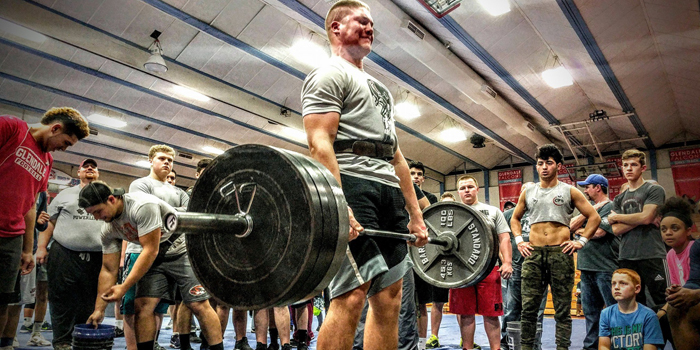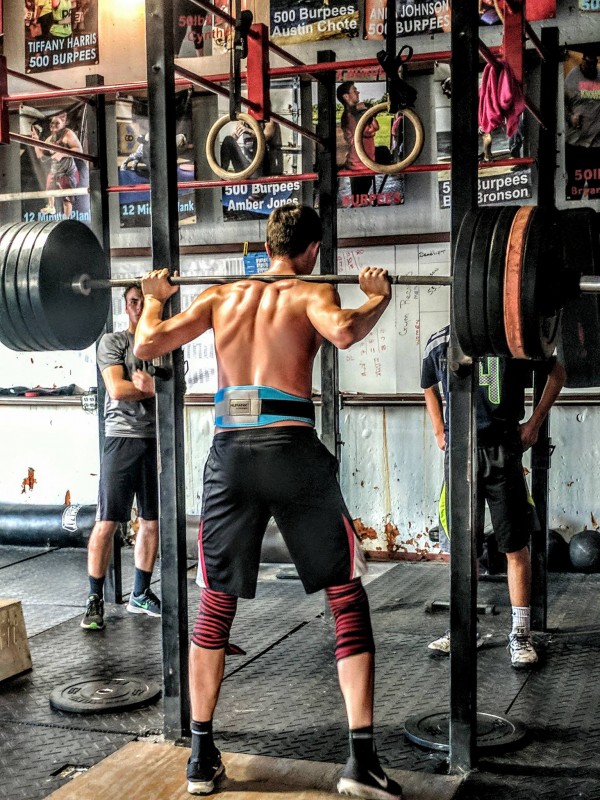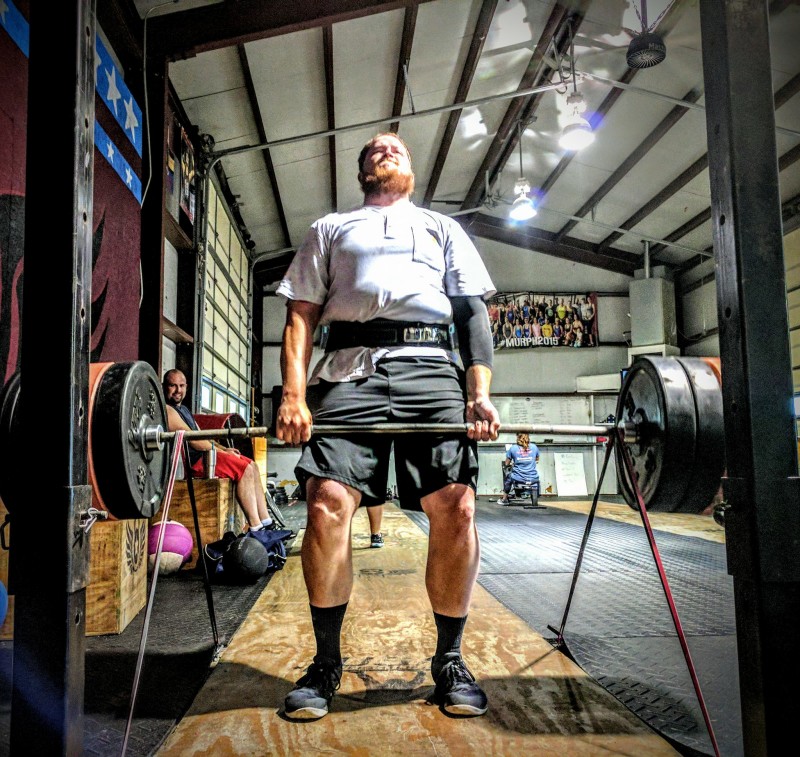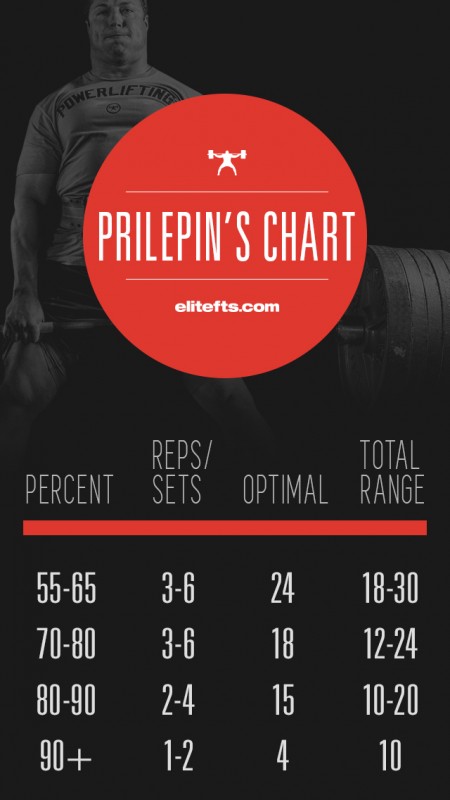
Before you begin reading, you'll need to understand that this isn't a “bro program.” For the average gym member, this program is far too advanced. This is intended for serious athletes who are actively competing in their chosen sport. Specifically, this is geared towards powerlifters, Olympic weightlifting athletes, and sports specific coaches needing their athletes to compete at a high level who can also have those athletes monitored and watched closely.
Throughout reading, you'll see terms that you must be familiar with to understand the intended effects of what's being discussed. Following is a list of these terms.
Sarcoplasmic Hypertrophy
Sarcoplasmic hypertrophy is the process of increasing muscle size by increasing semifluid plasma between the muscle fibers. This process greatly increases the size of the muscle but makes the cross-sectional area of the muscle less dense. The muscle will be bigger and weigh more, but there are no strength increases from it because the plasma inside of the muscle is non-contractile. Fluid can fill an area, but fluid cannot contract. A great example of a sport focused on sarcoplasmic hypertrophy training is bodybuilding. While their muscles may be large, they are mostly for show.
MORE: Bigger Is Not Always Stronger: Fallacies of Muscle Hypertrophy for Strength Athletes
While sarcoplasmic hypertrophy may be used for bodybuilding by most, it also has great uses for increasing health of connective tissue, which is paramount for injury prevention. This type of training can also be beneficial for an athlete, such as a football lineman who is in need of increasing weight while adding as little fat as possible or a basketball player who is unusually small and needs the increased weight to not be pushed around easily on the court.
Myofibril/Sarcomere Hypertrophy
This is when we have an increase in sarcomeres, which is what comprises the myofibrils within the muscle. The myofibrils are hair-like structures that are what causes the muscle to contract. While the sarcomeres are what make up the myofibril, from here on out we will refer to this as myofibril hypertrophy.
Accommodating Resistance
Accommodating resistance is the use of chains and bands to increase the force velocity curve. The body is made up of lever systems. When you're at your lowest on the squat, your lever system is it it's weakest. That's why you see “bros" in the gym doing quarter squats because that high the lever system is at their strongest. It's harder to use full range of motion so they simply won't and happily let their knees pay the price without getting full results. Remember, partial reps mean partial results.
Post-Activation Potentiation (PAP)
Post-activation potentiation is the result of a muscle being able to produce more force than normal based on recent muscle contraction. An easy example is if you want your athlete to get a new 1RM for back squat at 300 pounds, you first load the bar with 350 to 400 pounds and let it sit on their back and perform partial reps. You want to let them hold it for 15 to 20 seconds. What's happening in the body is that the nervous system is now used to and prepared to move this much heavier than intended load, and the result will be a much more effective lift when attempting the new, true PR with a lighter weight.
In this writing, we will only be discussing the use of bands. While chains work for this and look cool to use, the results are subpar when compared to bands.
Bands train our body to accelerate much faster than free weights can while also increasing power production, explosiveness, and force development, which is great for the development of power. If you're an athlete of any sport, to become a greater athlete you must increase your power and explosiveness. The bands will train the body to control the bar during the eccentric phase of a movement, increasing elastic kinetic potential energy. The body will use that energy through the concentric phase. It's the stretch reflex. When using bands, we don't rely solely on barbells. My athletes jump with them often. My strength athletes perform a minimum of 40 jumps a week using bands setup in different ways for different effects, while my basketball athletes jump a minimum of 40 times a day.
Beyond the force velocity curve, there is a much greater benefit from accommodating resistance, and that is the nervous system response to them. Every response we want from our muscles for any movement is based on how hard they can contract. How hard a muscle can contract is based on the motor units within each muscle, which is controlled by the nervous system. When using bands the load increases with every inch you stretch. The body has to react to this continually increasing load and it does so by making the nervous system recruit more motor units to make the muscle contract harder. The harder the muscle can contract, the more explosive power you get in return.
Supercompensation
Supercompensation is the process in which a workout will break our body down, resulting in an adaptation that makes the body more prepared for the upcoming workloads. The body can only adapt to the load placed on it; supercompensation explains it. Directly after a workout, fatigue sets in and the body at that point is less capable of doing the same work. As the body recovers, its level of fitness in whatever specific situation trained will rise to levels above previous. With supercompensation we continuously build upon that, making the body stronger, faster, or specifically for the intended training effect.
This program was born out of a lot of trial and error in working on my own programming over 15 years, and the programming of my powerlifters, weightlifters, and functional fitness athletes.

The basis of this program is to move in a linear progression by alternating rep ranges with normal deload and sarcoplasmic hypertrophy phases to allow for supercompensation to take place, while also taking time to focus on high rep, low weight movements to increase muscle mass and strengthen the connective tissue. The reason for staying with a higher intensity for the majority of the time is that the body will only adapt to the stimulus put on it, so we're giving plenty of opportunities to adapt in different blocks while also allowing it time to rest with regular deloading.
This program has many influences based on the coaches and programs that I look to for inspiration, including the Westside Barbell method, Mash Method, 5/3/1, Supertraining, and the Texas Method by my good friend Glenn Pendlay, as well as borrowing from my time as a bodybuilder.
You're going to notice that there is constant change in these movements. We never do anything for more than three weeks. This prevents us from falling to the law of accommodation, while also keeping things fresh. According to Louie Simmons, after three weeks of doing the same movements, the body stops getting stronger and faster. Borrowing from his knowledge, we implement that into our program by changing the rep schemes.
You'll see that there are repeating patterns for the different blocks that swing from one to another. You'll be working in rep ranges of five sets of five reps, five sets of three reps, eight sets of one rep, and very high volume/ light intensity work. There are specific reasons for these rep schemes.
WATCH: Table Talk — When to Rotate Supplemental and Accessory Exercises
The lower the reps, the more strength/myofibril hypertrophy focused the movement is, and as the volume increases the more it moves to a sarcoplasmic hypertrophy effect. This is building muscle size and helping to increase the strength and health of the connective tissue.
When we are in the five-rep ranges we are building a combination of strength, speed, and mass. It isn't bodybuilding mass, but there will still be a slight amount of sarcoplasmic hypertrophy taking place. The majority of the benefits from this range, however, will be myofibril hypertrophy. When doing these movements you want the bar to move as fast as possible to build speed strength. The benefit of the sarcoplasmic hypertrophy in this instance is that it will help to stretch out the muscle to make more room for new muscle fibers and for myofibril hypertrophy to take place while you're progressing.
Within the three-rep range, we are focusing strictly on increasing strength and making myofibril hypertrophy take place. This is heavy lifting; we want the body to feel the stress of the weight and respond accordingly. Remember, the body can only adapt to the stimulus placed on it.
The week of sarcoplasmic hypertrophy is often one of the most fun for the athletes. This is called the submaximal effort method or the repetition method. Athletes seem to always look forward to this because it's completely different, has a totally different stimulus, and provides a great pump to the muscle. The main reason for this work, though, is that the low intensity/high volume work is good to strengthen the tendons and ligaments, which get stronger at a much slower pace than the muscles. We consider this to be prehab: it's work we do to prevent future entries. Another important benefit is that the high volume work is very beneficial for softening the arteries while working the heart. Heavy weight training can harden the arteries; we need this cardio type work to help soften them so we have that balance for our overall health.
When we do the eight sets of one rep, we intend to increase your max lifts every time. This is the max effort method based on Prilepin's chart, which was popularized by Westside Barbell. This is truly max effort work, and within this process, if you want to go for a new max go ahead, but adjust the weight for the following reps accordingly. This is your opportunity to feel like an animal. Before you do your sets, I suggest you load the bar with more than you're going to actually need (except deadlift). If it's back squat day and your working weight is 300 pounds, put 375 or 400 on there, stand up with it, and let your nervous system become adjusted for that weight. When you move the lesser weight your body will be prepared for something heavier and will move much easier. This is also suggested for when attempting a one-rep max. This is called post-activation potentiation (PAP) and is a lesson learned from one of the best USAW coaches, Travis Mash. It is detailed very well in his book the Mash Method.
Each Friday during the five-rep and three-rep blocks we will be getting a new five-rep back squat max, without bands. If you cannot get a new five-rep max, you must do five sets of five at 90% of your five-rep max. We take a page from Glenn Pendlay on this from his very popular Texas Method.
Deloading is an absolute necessity. You'll find many opinions about if you should deload or not, but the correct answer is that on this program we deload and it is a must. The reason is that we are doing a lot of heavy work, often. We have to let supercompensation take place. Supercompensation is the process of the muscles that are broken down recovering and getting stronger. With the amount of work you will be doing, you must deload. How you deload is up to you. I suggest laying off the weights and doing a bit of light cardio, getting a massage, or whatever else you do to relax. When you finish your deload week you will be stronger the next week.

In this writing, we will not be going into the accessory lifts. Accessory lifts are intended to bring up your main lifts by targeting your weaknesses. When you're doing your main lifts you are training the lift; when you're doing accessory work you are building the lift. Because everyone is different, I will let you decide on your own accessory work and not dictate it within this program. If you follow a functional fitness type of training method, make sure your main lift is always completed first with you daily workout incorporating your accessory movements in it.
The structure of the program follows with a sample program after. At this point, we will assume you already have a 1RM on all the needed lifts. If you do not, establish one before starting. Once you have completed the program, there are other ways to change the Swing Block Method to suit your needs. If you're gaining a great amount of strength, you will want to double your sarcoplasmic hypertrophy weeks by putting one in the middle of your cycle to increase joint and tendon health.
The most important aspect of this program which can not be changed is the three weeks of work followed by a transition to another rep scheme, with regular sarcoplasmic hypertrophy week, deload weeks, and max effort weeks.
This program has been used by members of Barton County Strength Club with amazing results. Over the past summer by using this method our members have secured over 115 state and national records in both Powerlifting and Olympic lifting.

The Swing Block Method
Week 1
- We take a week to measure strength and set a record on with a five-rep max.
Weeks 2-4
- Five sets of five at 75% to 90% of your five-rep max. We use this percentage because, firstly, we want to be able to get all the working reps accomplished. It also allows you to adjust on days when you're simply not up to par. During the sets, if you can get a new rep max, go for it, but increase the percentages following based on your new max. I suggest staying at 90% of you can handle the intensity.
Week 5
- Max Effort Work
- During this week we bring our volume way down and the intensity up. We will perform eight reps at 90% to 95% on our core lifts. The weights are based on Prilepin's chart. This isn't intended to be completed in sets, but single reps. If you can do these in reps, you aren't using enough weight. Between each rep you should take a minimum of two minutes, with three to four being preferred. We do this because we want the energy system being used, the adenosine triphosphate (ATP) system, to be completely recovered. When focusing on strength training, take all the rest you need between your reps, but don't let your muscles get cold.
Week 6
- Sarcoplasmic Hypertrophy Week
- We do this for a few reasons. We want to increase muscle size but the most important factor in terms of strength building is to increase the strength of the connective tissue. Another important benefit is that we force ourselves to do some cardiovascular training, which is very important for health and longevity. Heavy weight training can harden artery walls, while cardiovascular training will soften them.
Week 7
- Deload
Week 8
- We take this week to measure strength and set a record on with a three-rep max. The weights should be a decent amount heavier than the weight used with the previous five-rep ranges.
Weeks 9-11
- Five sets of three at 75% to 90% of your three-rep max. This is the same as the sets of five. The weights may be heavier, but you should come closer to getting all the reps.
Week 12
- Max Effort Work
- Eight reps at 90% to 95%
Week 13
- Sarcoplasmic Hypertrophy Week
Week 14
- Deload
Week 15
- We max out again on all of our core lifts, this time with accommodating resistance.
Week 16
- The cycle repeats.
Sample Program
This is just a sample; you place your lifts where you want them to be based on your sport.
Week 1
- We establish a 5RM on all the core lifts. Following your core lifts you'll focus on your assistance work and your cardio. If you focus on cardio make sure your cardio compliments your strength. For example, if you bench on Monday you will want your cardio to include push-ups or another movement that works the chest and triceps.
Monday
- Bench Press: 5RM
- Snatch: 5RM (if weightlifter)
Tuesday
- Back Squat: 5RM
- Clean: 5RM (if weightlifter)
Wednesday
- Rest
Thursday
- Front Squat: 5RM
- Push Press: 5RM
- Clean: 5RM
Friday
- Deadlift: 5RM
- Snatch-Grip Deadlift: Max
Weeks 2-4
- Now that we have established our five-rep max we are going to be using them in our training to perform five sets of five of that number. Remember, 75% to 90%, but the higher the better.
- If at any time during these weeks you are feeling strong and want to go for a new five-rep max at the end of your set, go for it. If you get one, be sure to increase the percentage used for the rest of the cycle.
Monday
- Bench Press: 5x5 with 5RM Percent
- Snatch: 5x5 (if weightlifter)
Tuesday
- Back Squat: 5x5 with 5RM Percent
Wednesday
- Rest
Thursday
- Front Squat: 5x5 with 5RM Percent
- Push Press: 5x5 with 5RM Percent
- Feel free to lower the weight significantly to save your shoulders if need be. Many people train not to become the strongest on earth but simply for health. If your shoulders hurt or have had prior injuries, drop the percentage as much as you need or remove the lift completely.
Friday
- Deadlift: 5x5 with 5RM Percent
Week 5
- This week we focus on max effort work. While performing the lifts, if you're feeling strong and feel like you can get a new max, go for it. If you do get a new max early in the set change the remaining percentage to reflect the new max.
Monday
- Bench Press: 8 reps with 90-95%
- Snatch: 8 reps with 90-95%
Tuesday
- Back Squat: 8 reps with 90-95%
Wednesday
- Rest
Thursday
- Front Squat: 8 reps with 90-95%
- Clean and Jerk: 8 reps with 90-95%
Friday
- Deadlift: 8 reps with 90-95%
- Overhead Squat: 8 reps with 90-95%
Week 6
- This week we focus on sarcoplasmic hypertrophy to not only add a different stimulus to the muscles but to focus on joint health. For this week we will do all of our movements using a Tabata timer. We do very high rep and low weight movements. Every movement is done for four minutes using eight rounds of 20 seconds of work with 10 seconds of rest. For most of these movements, the bar and body weight is plenty. This week we do not lift heavy.
Monday
- Tabata Bench Press
- Tabata Flys
- Tabata Decline Push-Ups
- Tabata Dips
- Use the example above of Monday to set up the rest of the week to work the muscles in the same manner
Week 7
Monday
- Bench Press: Max
- Snatch: Max (if weightlifter)
Tuesday
- Back Squat: Max
Wednesday
- Rest
Thursday
- Front Squat: Max
- Clean and Jerk: Max
Friday
- Deadlift: Max
Week 8
- Deload
Week 9
- Now we will move to using accommodating resistance. We are getting band tension and getting a new five-rep max with them. We are looking for 30% to 50% band tension at the top. We are also replacing the push press with a clean and jerk.
Monday
- Bench Press: 5RM with Accommodating Resistance
- Snatch: 5x5 (if weightlifter)
Tuesday
- Back Squat: 5RM with Accommodating Resistance
Wednesday
- Rest
Thursday
- Front Squat: 5RM with Accommodating Resistance
- Clean and Jerk: 5RM with Accommodating Resistance
Friday
- Deadlift: 5RM with Accommodating Resistance
Weeks 10-12
- At this point we are changing the days some core lifts are performed so we can add another day for back squat. The volume for the core lifts is increasing while adding variation.
Monday
- Back Squat: 5x5 with 5RM with Accommodating Resistance
- Snatch: 5x5 with 60% (if weightlifter)
Tuesday
- Bench Press: 5x5 with 5RM with Accommodating Resistance
- Deadlift: 8 reps with 90-95%
Wednesday
- Rest
Thursday
- Front Squat: 5x5 with 5RM with Accommodating Resistance
- Clean and Jerk: 5x5 with 5RM with Accommodating Resistance
Friday
- For back squat, set a new five-rep max without bands. If you do not set a new max, perform 5x5.
- Bench Press: 8 reps with 90%
Week 13
- This is sarcoplasmic hypertrophy week. This is the exact same as before, with no accommodating resistance.
Week 14
- Deload
Week 15
- During this week we are measuring our new totals across the board while adding a new max effort movement: the box squat.
Monday
- Bench Press: Max
- Snatch: Max (if weightlifter)
Tuesday
- Back Squat max
Wednesday
- Rest
Thursday
- Front Squat: Max
- Clean and Jerk: Max
Friday
- Deadlift: Max
- Box Squat: Max
Week 16
- We start the cycle over at this point with the core movements, minus accommodating resistance. If your assistance work calls for accommodating resistance, go for it.
Week 17
Monday
- Back Squat: Set new 5RM
- Snatch: Set new 5RM (if weightlifter)
Tuesday
- Bench Press: Set new 5RM
Wednesday
- Rest
Thursday
- Front Squat: Set new 5RM
- Clean and Jerk: Set new 5RM
Friday
- Deadlift: Set new 5RM
Week 19
Monday
- Back Squat: 5x5 with 5RM
- Snatch: 5x5 with 60% (if weightlifter)
Tuesday
- Bench Press: 5x5 with 5RM
- Deadlift: 8 reps at 90-95%
Wednesday
- Rest
Thursday
- Front Squat: 5x5 with 5RM
- Clean and Jerk: 5x5 with 5RM
Friday
- Back Squat: Set a new 5RM. If you do not set a new max, perform 5x5
- Box Squat: 8 reps with 90-95%
At this point, the pattern repeats indefinitely.
Images courtesy of Barton County Strength Club
Jeremy Augusta is the owner of Barton County Strength Club which is known for their extremely successful competitive strength team. Jeremy is a USAW L2 coach with 15 years fitness experience with background in MMA, powerlifting, Olympic Weightlifting, and bodybuilding, all which come together in his programming.












2 Comments